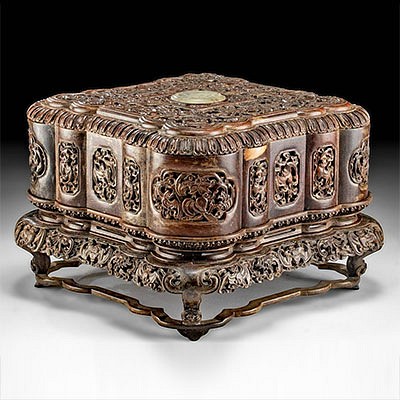12th C. Central Asian Ghaznavid Silver Ram / Sphinx
Lot 32d
About Seller
Artemis Fine Arts
686 S Taylor Ave, Ste 106
Louisville, CO 80027
United States
Selling antiquities, ancient and ethnographic art online since 1993, Artemis Gallery specializes in Classical Antiquities (Egyptian, Greek, Roman, Near Eastern), Asian, Pre-Columbian, African / Tribal / Oceanographic art. Our extensive inventory includes pottery, stone, metal, wood, glass and textil...Read more
Categories
Estimate:
$5,000 - $8,000
Absentee vs Live bid
Two ways to bid:
- Leave a max absentee bid and the platform will bid on your behalf up to your maximum bid during the live auction.
- Bid live during the auction and your bids will be submitted real-time to the auctioneer.
Bid Increments
| Price | Bid Increment |
|---|---|
| $0 | $25 |
| $300 | $50 |
| $1,000 | $100 |
| $2,000 | $250 |
| $5,000 | $500 |
| $10,000 | $1,000 |
| $20,000 | $2,500 |
| $50,000 | $5,000 |
| $100,000 | $10,000 |
| $200,000 | $20,000 |
About Auction
By Artemis Fine Arts
Apr 8, 2021
Set Reminder
2021-04-08 10:00:00
2021-04-08 10:00:00
America/New_York
Bidsquare
Bidsquare : Fine Antiquities | Asian | Ethnographic Art
https://www.bidsquare.com/auctions/artemis-gallery/fine-antiquities-asian-ethnographic-art-6770
Features classical antiquities, ancient and ethnographic art from cultures encompassing the globe. Egyptian, Greek, Roman, Etruscan, Near Eastern, Asian, Pre-Columbian, Native American, African / Tribal, Oceanic, Spanish Colonial, Russian, Fine Art, so much more! All legally acquired, legal to sell. Artemis Fine Arts info@artemisfinearts.com
Features classical antiquities, ancient and ethnographic art from cultures encompassing the globe. Egyptian, Greek, Roman, Etruscan, Near Eastern, Asian, Pre-Columbian, Native American, African / Tribal, Oceanic, Spanish Colonial, Russian, Fine Art, so much more! All legally acquired, legal to sell. Artemis Fine Arts info@artemisfinearts.com
- Lot Description
Central Asia, Iran, Afghanistan, Pakistan, & Transoxiana, Ghaznavid Dynasty, ca. 12th century CE. An incredible, rare example of Ghazni metalwork, made from 80% silver, in the form of an exquisite ram-sphinx with delicate incised motifs covering its body. This mythical creature features the magnificent, erect head of a ram with huge curled horns, two human-like breasts that project from its broad chest, and incised elaborate wings covered in feathers along its flanks. Other motifs are also incised on its body - round abstract symbols at the top of each leg, and more feather-like motifs along the neck, chest, and back. The body is wonderfully rounded and stands atop tapering column-like legs that end in flat nubs incised to resemble hooves. Another round symbol containing a many-petaled flower is on the back of the head. Size: 6.35" W x 7.4" H (16.1 cm x 18.8 cm); silver quality: 80%; 280 grams total weight
Ghaznavid rulers gathered immense wealth by raiding Indian cities and taking tribute from Indian rulers; indeed they are credited with bringing Islam to the Indian subcontinent. The silver that this ram is made from likely came from these activities, though the Ghaznavids also benefited from being at the crossroads of the Silk Road. Ghaznavid metalwork is little known, in part because many of the empire's remains are in modern day Afghanistan, whose recent history has prevented much archaeological research. Most of our knowledge of their artwork comes from the site of Lashkar-i Bazar, a walled royal suburb and series of grand of palaces built during the 12th century and destroyed by the Mongols in the early 13th. It was excavated by a French expedition in 1949-1951. There, marble reliefs, painted tiles, ceramics, and metalwork all reveal a fantastical, imaginative worldview populated by magical creatures like this ram-sphinx. Griffons, harpies, and sphinxes guarded the palace and the sultan. The round symbols on this figure's body correspond to others painted on the bodies of sphinxes and harpies on tiles - probably magical, protective signs whose origins date to Classical Persia.
See "Reflection of Ghaznavid Palace Decoration on Anatolian Seljuj Palace Decoration" by Gonul Oney, Turkey, 1975.
Provenance: private California, USA collection, purchased in a Los Angeles, California, USA antique store in the 1970s
All items legal to buy/sell under U.S. Statute covering cultural patrimony Code 2600, CHAPTER 14, and are guaranteed to be as described or your money back.
A Certificate of Authenticity will accompany all winning bids.
We ship worldwide and handle all shipping in-house for your convenience.
#149135Piece shows repair running the entire length of the body where it was joined from two pieces. Restoration to the chest and inside of front legs. Slight bending to form as shown, notably on the horns. Motifs on body and form are overall well preserved.Condition
- Shipping Info
-
All shipping is handled in-house for your convenience. Your invoice from Artemis Gallery will include shipping calculation instructions. If in doubt, please inquire BEFORE bidding for estimated shipping costs for individual items.
-
- Buyer's Premium



 EUR
EUR CAD
CAD AUD
AUD GBP
GBP MXN
MXN HKD
HKD CNY
CNY MYR
MYR SEK
SEK SGD
SGD CHF
CHF THB
THB
















